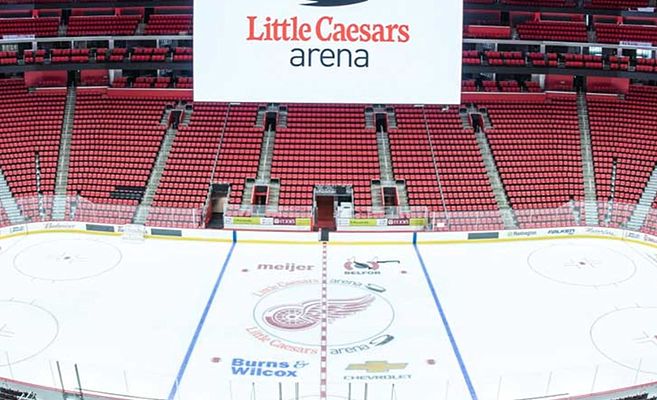The Infrastructure that Brings Technology to Life at Little Caesars Arena
Stadiums, arenas and ballparks are using AV and communications technology as a differentiator, coming up with ways to wow fans and bring them even closer to the action.
Containing more commercial AV than nearly any other professional venue in the world, Little Caesars Arena in Detroit, MI, is a shining example of a venue packed with automation and technology to boost the fan experience and help staff improve efficiency. As the new build began, the venue’s goal was to be one of the most technologically advanced venues ever built when it opened its doors in late 2017.
Home to the Detroit Red Wings and the Detroit Pistons, the arena holds 20,000 fans and utilizes state-of-the-art technology in every corner (and even takes excitement from the event out into the city!) through features like:
- A 5,100-square-foot, center-hung, 360-degree video board – the world’s largest seamless scoreboard
- Four large under-mount displays
- More than 45 LED displays
- iPad control of suite lighting, drapes, temperatures, TV screens and food/beverage orders
- Interactive story walls
- A 900-square-foot outdoor video board
- Electronic parking signs
- 1,500+ IPTV connections
- 300 suite screens that display advertising, real-time game updates and menus
- Networked point-of-sale systems

To make sure this technology works seamlessly, high-speed, high-bandwidth wired and wireless connectivity solutions were needed throughout Little Caesars Arena. More than 1,000 access points allow fans to stream content, post photos and share experiences on social media wherever and whenever they want (some access points are even installed under seats to bring signals closer to users). Wireless coverage extends to the retail, entertainment office and residential units outside Little Caesars Arena’s perimeter as well.
The arena’s network is made up of more than 12,000 active ports and 45 intermediate distribution frames (IDFs) that connect cables between devices and a main distribution frame (MDF).
To bring all of this technology to life, there were three things Little Caesars Arena needed from an infrastructure standpoint:
1. Large Amounts of Fiber Cable
A fiber backbone (two 100G fiber connections) for the venue provides interconnections between access provider space, entrance facilities, equipment rooms, telecommunication rooms, telecommunication enclosures and buildings. This high-bandwidth backbone ultimately creates the “skeleton” that supports the rest of the network.
To support 100G applications, Belden low-loss OM4 fiber cabling was installed to allow extended reach for ultra-long runs.
FiberExpress Fusion Splice-On Connectors were also utilized to permanently join fiber stubs inside the connector with fiber cables; they combine the benefits of fusion splicing with the simplicity of field-installable connectors to reduce installation errors and eliminate the need for crimping, polishing and adhesives.
2. High-Performance Category 6A Cable
Belden 10GXS Small-Diameter Category 6A Cable was deployed inside Little Caesars Arena, with its simple, compact design that makes the most of available space without compromising performance. The cable supports 10G transmission speeds and saves up to 25% on space and weight when compared to traditional Category 6A cables.
The small bend radius allowed the cable to be installed in tight spaces throughout the venue; easy-to-separate pairs and easy-to-remove barrier tape allowed for fast termination and installation to keep the project moving.
3. Preassembled Data Center Cabinetry
For convenience – and to keep the project timeline in check – all enterprise data center cabinetry and cable management systems arrived fully tested and assembled according to specific requirements from the onsite electrical and low-voltage integrator.
The equipment was immediately ready for deployment with no additional configuration required. The cabinets were built to specifications, labeled according to preferences, loaded into a delivery truck in reverse order and unloaded row by row for the fastest installation possible.
Supporting High-Tech Advances
With all of these infrastructure components now in place, Little Caesars Arena has the cabling and connectivity it needs to support today’s high-tech advances, as well as whatever technology developments emerge down the road. Fans can expect a once-in-a-lifetime experience – whether they’re inside or outside the venue.
Want to learn more? Read about how we helped Little Caesars Arena achieve its goal of becoming one of the most technologically advanced stadiums ever built.
![System.String[]](https://assets.belden.com/transform/d0c8999f-5f0a-4222-ac53-1c5efd10beec/Sean-McCarthy-new?io=transform:fill,width:300,height:300)